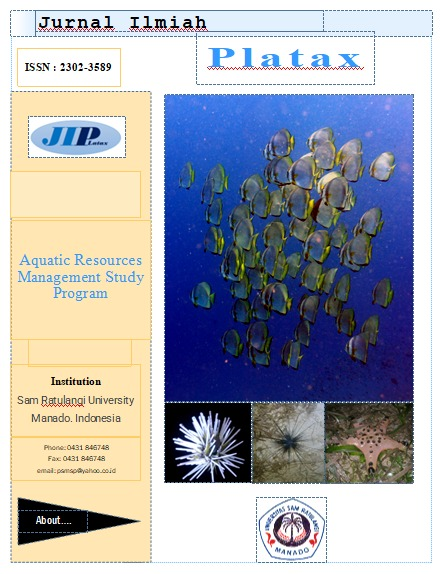Morphological Characteristics and Shell Color Of Littoraria pallescens Prosobrancia Molusca From Different Mangrove In Tongkaina Waters, Manado City
DOI:
https://doi.org/10.35800/jip.v10i1.38559Keywords:
Littoraria pallescens, Mangrove, Shell color, MorphologyAbstract
The purpose of this study was to identify sea slugs L. pallescens taken from two different mangroves, namely Rhizophora mucronata and Avicennia marina in Tongkaina waters, Bunaken District, Manado City based on morphology and anatomy as well as shell color. Identification of mangroves and sea slugs refers to the identification book. The results obtained were L. pallescens species with elongated and tapered morphology at the end of the shell measuring 0.3-2.7 cm. The operculum is purple. The color of the shell obtained was 66.85% consisting of dark colors (black, black, orange, brown and gray spots), occupying the stems and roots of the mangrove, while the light colors (yellow, yellow, dark spots and red) were found to be 33.15%, occupying the leaves and stems of mangroves. The high survival rate of L. pallescens was found in the mangrove roots. This species was found in R. mucronata by 65.26% while in A. marina only 34.74%, this could be caused by differences in the shape of the mangrove roots.
Keywords: L. pallescens; Mangrove; Shell color; Morphology
Abstrak
Tujuan penelitian ini adalah mengindentifikasi siput laut L. pallescens yang diambil dari dua mangrove berbeda yaitu Rhizopora mucronata dan Avicennia marina di perairan Tongkaina, Kecamatan Bunaken, Kota Manado berdasarkan morfologi dan anatomi serta warna cangkang. Identifikasi mangrove dan siput laut merujuk pada buku identifikasi. Hasil penelitian yang diperoleh yaitu spesies L. pallescens dengan bentuk morfologi memanjang dan meruncing, pada bagian ujung cangkang berukuran 0,3-2,7 cm. Operculum berwarna ungu. Warna cangkang yang diperoleh 66,85% yang terdiri dari warna gelap (hitam, hitam bercak orange, coklat dan abu-abu), menempati bagian batang dan akar mangrove sedangkan warna terang (kuning, kuning bercak gelap dan merah) didapat 33,15%, menempati bagian daun dan batang mangrove. Tingginya kelangsungan hidup L. pallescens berada pada bagian akar mangrove. Spesies ini ditemukan pada R. mucronata sebesar 65,26% sedangkan pada A. marina hanya 34,74%, hal ini dapat disebabkan oleh karena perbedaan bentuk akar mangrove. Â
Kata Kunci: L. Pallescens; Mangrove; Warna cangkang; Morfologi
References
Boneka, F.B., Lumingas, L.L.J., Saroinsong, V. 1997. Growth and Mortality of Littoraria pallescens, with emphasis on two colour morphs, in northern Sulawesi, Indonesia. Phuket Marine Biological Center Special Publication.
Boneka, F. B. 2013. Pengantar Ekologi Laut. Press UNSRAT
Dahuri, Rokhmin. 2001. Pengelolaan Ruang Wilayah Pesisir Dan Lautan Seiring Dengan Pelaksanaan Atonomi Daerah. Mimbar, Vol. 17 No. 2: 139 – 171
Reid, D. G. 1986. The Littorinids Molluscs of Mangrove Forests in Indo-Pasific Region: the genus Littoraria. British museum (Natural history). London. 228 hal.
Dharma, B. 1988. Siput dan Kerang Indonesia (Indonesian Shells). P.T. Sarana Graha, Jakarta.
Isnaningsih, N. I., Mufti, P.P. 2018. Peran Komonitas Moluska Dalam Mendukung Fungsi Kawasan Mangrove di Tanjung Lesung, Pandeglang, Banten. Jurnal Biotropika Vol. 6 No. 2
Noor, Y., M. Khazali., I.N.N. Suryadiputra. 2006. Panduan Pengenalan Mangrove Di Indonesia. PHKA/IP, Bogor. 220 Hal.
Sumampow, M. S., Mantiri, H. M. D., Boneka, B. F., Ompi, M., Paulus, H. J., Wantasen, A. 2018. Klasifikasi Warna Cangkang Dan Pigmen Karotenoid Pada Littoraria pallescens (Philippi, 1846) Dari Wilayah Ekosistem Mangrove Kelurahan Mokupa Kecamatan Tombariri Dan Kelurahan Basaan Kecamatan Ratatok. Jurnal Ilmiah Platax Vol. 6 No.2
Downloads
Published
How to Cite
Issue
Section
License
COPYRIGHT
Authors who publish with this journal agree to the following terms:
Authors hold their copyright and grant this journal the privilege of first publication, with the work simultaneously licensed under a Creative Commons Attribution License that permits others to impart the work with an acknowledgment of the work's origin and initial publication by this journal.
Authors can enter into separate or additional contractual arrangements for the non-exclusive distribution of the journal's published version of the work (for example, post it to an institutional repository or publish it in a book), with an acknowledgment of its underlying publication in this journal.
Authors are permitted and encouraged to post their work online (for example, in institutional repositories or on their website) as it can lead to productive exchanges, as well as earlier and greater citation of the published work (See The Effect of Open Access).




















